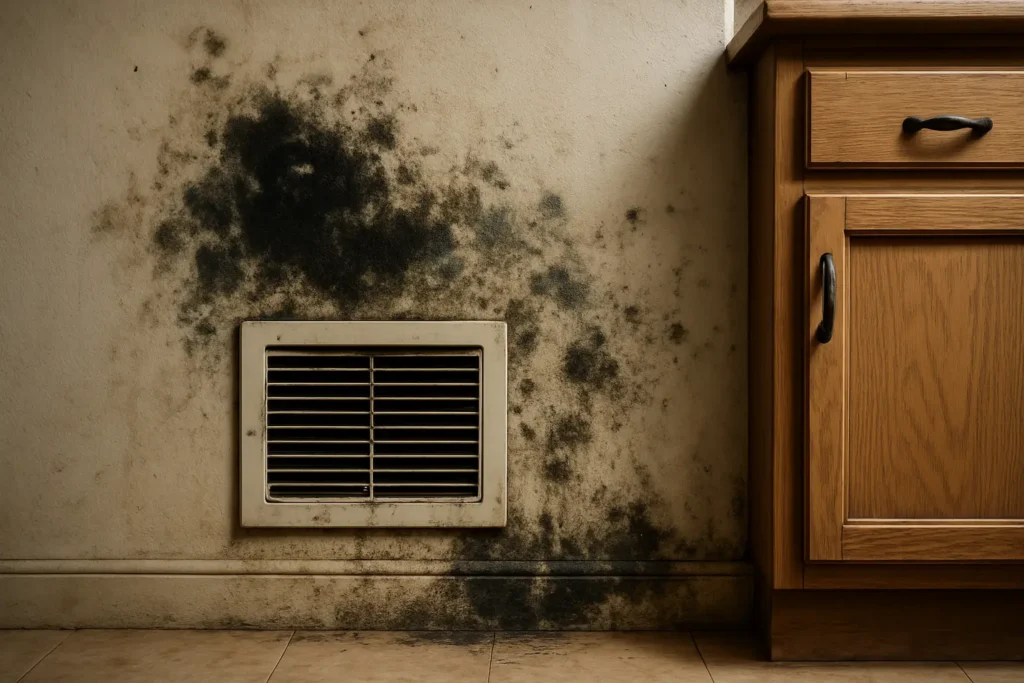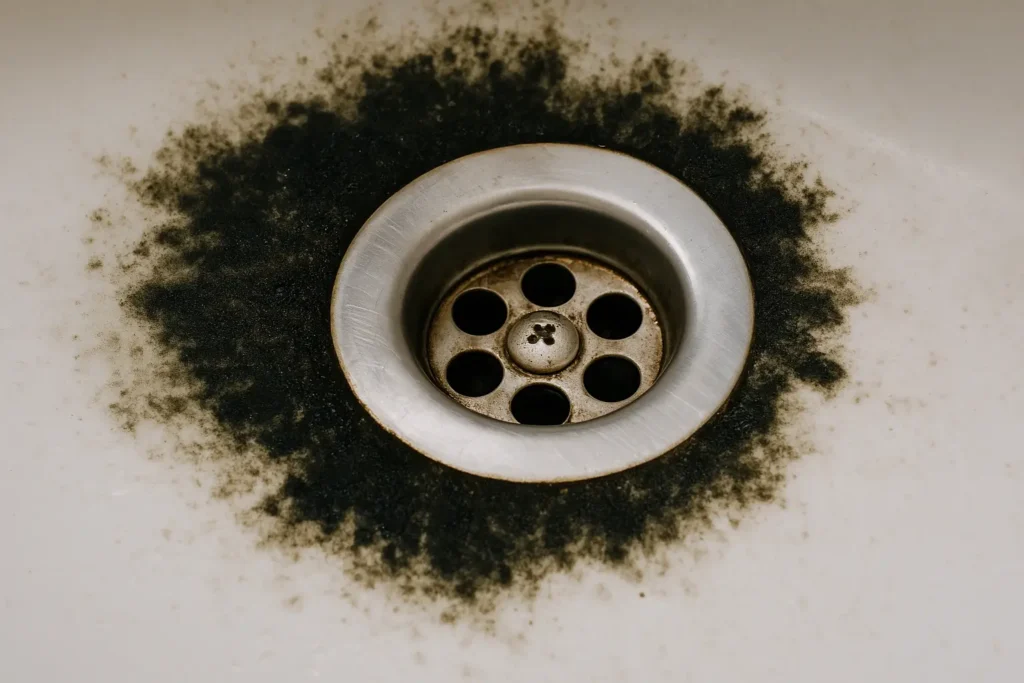What Does Mold Smell Like, and How Can I Detect It?

You walk into your home and catch a strange, lingering smell. It’s not exactly garbage, not quite pet odor, and not something you can easily describe, but it’s there. Maybe you’ve cleaned the sink, taken out the trash, and still… it stays. This could be more than just a bad smell, it could be mold. Mold often hides behind walls, under floors, and inside vents. And before you ever see it, you’ll likely smell it. That musty, unpleasant odor is one of the first signs that something deeper might be wrong. In this post, we’ll help you identify what mold smells like, explain what different types of mold might smell like, and share how you can track down the source and remove it safely. What Does Mold Smell Like? Most people describe mold as having a musty, damp, earthy scent, kind of like old books in a basement or wet clothes left in a washing machine. But the smell can vary depending on the type of mold, how long it’s been growing, and where it’s hiding. If the air in a room feels heavy or stale and has a funky smell you can’t seem to eliminate, mold might be the reason. What Does Black Mold Smell Like? Black mold, often caused by long-term moisture problems, tends to have a strong, musty odor that’s more intense than other types of mold. People often describe it as: Earthy Rotting wood Like wet socks or mulch The smell tends to stick around, especially in closed spaces like basements, under sinks, or behind walls. What Does Toxic Mold Smell Like? Not all black mold is toxic, but toxic molds, such as Stachybotrys chartarum, give off a very pungent and sour smell. It’s deeper and more chemical-like than regular mold. This smell might cause: Headaches Dizziness Nausea Irritation in your nose or throat Even if you don’t see it, if you’re reacting physically to a bad smell, take it seriously. It could be toxic mold growing behind the walls or the ceiling. Does Mold Smell Sweet? It may sound strange, but some molds can smell sweet or slightly fruity, especially in the early stages of growth or in high-humidity environments. People sometimes confuse it with: Overripe fruit Cotton candy Old wine This type of smell can be misleading. It might seem harmless at first, but a sweet smell in a damp room is a red flag. Can Mold Smell Like Cat Urine? Some molds do smell like cat pee or ammonia, especially when they’re growing on building materials like drywall or subflooring. Ammonia-like odors are common in certain mold types. If you smell what seems like cat urine but don’t have pets, that’s a good sign that something biological is going on behind the scenes. This kind of smell often shows up in: Wall cavities Attics HVAC systems If you have asthma or mold allergies, exposure might trigger more intense flare-ups or breathing difficulties. How to Detect Mold By Smell (Even If You Can’t See It) If you suspect a mold smell but don’t see visible signs, here’s how to investigate safely: 1. Trust Your Nose If a certain room or corner always smells strange, it’s worth checking, especially near plumbing, windows, basements, or crawl spaces. 2. Look for Other Clues Even if you can’t see mold, these are signs it may be hiding: Peeling paint or wallpaper Bubbling drywall Water stains or discoloration Condensation or high humidity in certain rooms 3. Use a Flashlight and Check Hidden Areas Shine a light behind and under: Sinks Cabinets Appliances Closets Baseboards 4. Use a Moisture Meter Affordable moisture meters can help you find hidden damp spots inside walls and floors—areas where mold may be growing. 5. Don’t Poke Around Too Much Disturbing mold (especially black mold) can release harmful spores into the air. If you strongly suspect mold is present but can’t reach it safely, call a professional to assess the situation. How to Get Rid of Mold Smell The key to removing the mold smell is removing the mold itself. Air fresheners or sprays will only mask the odor, it will come back again and again until the mold is gone. Steps to reduce mold odor: Dry out the area completely using fans and dehumidifiers Clean visible mold with vinegar or hydrogen peroxide (never mix cleaners!) Remove and replace mold-damaged materials (drywall, carpet, insulation) Disinfect surfaces using an antifungal solution Increase ventilation, use exhaust fans or open windows Call a mold remediation team if the smell keeps coming back When to Call a Professional If the smell is strong, spreading, or causing health issues, it’s time to bring in experts. A professional mold remediation team like Tradewinds Restoration can: Identify the exact location of hidden mold Test moisture levels behind walls or floors Remove contaminated materials safely Treat the space with industrial-grade antimicrobials Restore your indoor air quality and peace of mind Why Homeowners Trust Tradewinds Restoration At Tradewinds Restoration, we’ve helped hundreds of homeowners deal with mold, especially when the first sign is just a bad smell. We respond fast, investigate thoroughly, and treat your home like our own. We don’t just get rid of the smell, we get to the root of the problem. Think you’re smelling mold? Don’t wait. Call Tradewinds Restoration today. We’ll help you breathe easier, sleep better, and feel confident your home is clean and safe again. Follow Your Nose If you’ve asked yourself, “what does mold smell like?” or caught a whiff of something earthy, sour, or like cat pee, pay attention. Even if you don’t see mold, that smell could be the first warning sign that something is growing behind your walls. With the right tools, help, and fast action, you can fix the issue before it becomes a bigger problem. Contact us
Is Black Mold in a Sink Drain Dangerous?

You’re doing the dishes or brushing your teeth, and then you notice it. A strange black slime or fuzzy buildup creeping around the sink drain. Maybe it smells a little musty. Maybe it’s slimy to the touch. You clean it… But it keeps coming back. That black stuff in your sink drain might be black mold. And yes, it can be dangerous, especially if it’s been growing unchecked for a while. In this article, we’ll explain what black mold in sink drains is, why it forms, when it becomes a health concern, and what you can do about it. What Is Black Mold in a Sink Drain? Black mold in a drain is typically a form of fungus that grows in damp, dark, nutrient-rich places, like your kitchen or bathroom sink. While not all black-colored mold is toxic, one type, Stachybotrys chartarum (commonly called toxic black mold), produces harmful mycotoxins that can affect your health. Soap scum Food particles Hair and skin cells Moisture and heat These conditions make sink drains a perfect spot for mold and bacteria to grow. Is Black Mold Dangerous? It can be. Not every black mold in a drain is immediately harmful, but constant exposure to mold over time can trigger health symptoms, especially for: People with asthma Allergy sufferers Elderly individuals Infants and children Anyone with a weakened immune system The danger increases when: Mold spores become airborne Mold spreads into hidden parts of your plumbing or cabinets It’s left uncleaned for extended periods Breathing in these spores or having contact with contaminated water can cause mild to severe health reactions. Health Symptoms Linked to Mold in Drains Even mold hiding inside a drain can release spores into the air or splash moldy water onto surfaces. Common symptoms include: Coughing, sneezing, or wheezing Irritated eyes, nose, or throat Skin rashes or itchiness Headaches or dizziness Sinus pressure or nasal congestion If you have asthma or mold allergies, exposure might trigger more intense flare-ups or breathing difficulties. Why Does Mold Keep Coming Back in My Sink Drain? Mold will return if the root cause isn’t fixed. Here’s why it’s so persistent: Warmth + moisture: Hot water from cooking or washing creates humid air. Poor drainage: Slow drains keep the area damp. Organic buildup: Food, oils, or toothpaste are all mold “food.” Hidden growth: Mold can grow down inside pipes or behind/under sink components. Wiping around the drain only removes surface mold. If it’s deeper in the plumbing or surrounding structure, it’ll return quickly. Can Black Mold in the Drain Spread? Yes, and this is where things can go from gross to serious. If left untreated: Mold spores can spread into cabinets or walls It may reach areas under the sink, including wooden cabinetry or drywall Moisture can attract other pests, like cockroaches or drain flies Musty smells can linger in your kitchen or bathroom Once mold spreads behind walls or under surfaces, it becomes much harder and more expensive to remove. That’s when it’s time to bring in professionals. How to Clean Mold from a Sink Drain If the mold is minor and limited to the visible drain area, you can try the following cleaning steps: What You’ll Need: Rubber gloves Scrub brush or old toothbrush White vinegar or baking soda Boiling water Hydrogen peroxide (optional) Cleaning Steps: Boil water and pour it slowly down the drain to loosen grime and kill surface bacteria. Sprinkle baking soda into the drain, followed by vinegar. Let it fizz for 10–15 minutes. Scrub the drain and nearby surfaces. Rinse with more boiling water. For persistent mold, use hydrogen peroxide (3%) and let it sit before scrubbing again. Important: Avoid bleach in your drains as it can create toxic fumes, especially in combination with other cleaners. When to Call a Professional It’s time to get expert help if: Mold keeps returning after multiple cleanings There’s a strong, musty smell under the sink Cabinets, walls, or flooring near the sink show signs of mold You experience unexplained health symptoms You suspect water damage or leaks under the sink A professional restoration team can: Detect hidden mold behind and under sinks Dry and clean affected areas Remove and replace contaminated materials safely Prevent future mold from coming back Why Tradewinds Restoration Is the Right Call At Tradewinds Restoration, we’ve seen what starts as “just a little black stuff” around a sink turn into a much bigger mold problem. We know where to look, how to treat it, and most importantly, how to stop it from spreading. When you call us, we: Use moisture detection tools to locate hidden mold Provide professional mold removal and sanitation Repair or replace any damaged drywall or wood Offer advice to help prevent future mold growth Don’t let a small drain problem lead to long-term damage or health risks. Call Tradewinds Restoration today if you think black mold may be hiding around your sink drain. We’re here to help clean it up and keep your home safe. Don’t Ignore That Black Stuff Mold in your sink drain might seem minor at first, but it’s a sign of a larger problem. Left alone, it can lead to health issues, home damage, and a persistent battle with odors and stains. The good news? You can catch it early. And if it’s already out of control, Tradewinds Restoration is here to help. Contact us


